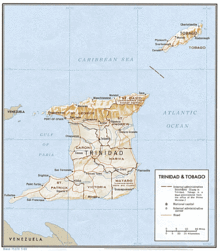Caroni County

Caroni County occupies 557 km2 (215 sq mi) in the west central part of the island of Trinidad, the larger island in the Republic of Trinidad and Tobago. It lies south and southwest of Saint George County, west of Nariva County and north of Victoria County. To the west it is bounded by the Gulf of Paria. County Caroni includes the town of Chaguanas, the largest town (by population) in the country. Administratively it is divided between the Borough of Chaguanas, the Couva-Tabaquite-Talparo Regional Corporation and the Tunapuna-Piarco Regional Corporation. The county was divided into four Wards: Chaguanas, Couva, Cunupia and Montserrat.
Caroni County, which takes its name from the Caroni River, stretches from the hills of the Central Range into the lowlands of the Caroni Plains and the Caroni Swamp. It is heavily associated with sugar cane and the Sugar Belt, but it actually accounts for no more than one third of the sugar belt. The now-defunct state-owned sugar company, Caroni (1975) Ltd took its name from the county.
Caroni is divided into four Wards - Cunupia, Chaguanas, Couva and Montserrat. The major towns of County Caroni are Chaguanas and Couva. The port and industrial zone of Point Lisas is also located in Caroni.
Caroni is often used symbolically to represent the Indo-Trinidadian heartland and the power base of the United National Congress.It is native to Doubles, Shellfish (mostly Crab) and many other different types of vending.Vendors are known to stand on the side of the highway under an umbrella selling their goods.
It is a very rural area and it's native to a lot of bush and agriculture.
References
- Anthony, Michael (2001). Historical Dictionary of Trinidad and Tobago. Scarecrow Press, Inc. Lanham, Md., and London. ISBN 0-8108-3173-2.
| ||||||||||||||||
